For anyone who has ever had the privilege of sharing their home with a rabbit, the sheer cuteness of these creatures is undeniable. From their twitching noses to their flopping ears, every part of a bunny seems designed to melt hearts. But there's one particular feature that often goes unnoticed, tucked away beneath layers of soft fur: the elusive yet adorable "bunny toe beans." While commonly associated with cats and dogs, the concept of paw pads, or "toe beans," in rabbits is a fascinating topic that sparks curiosity among pet owners and animal enthusiasts alike.
The term "toe beans" itself is a charming, colloquial expression used to describe the soft, padded areas on the underside of an animal's feet. These fleshy, rubbery cushions are typically pink or black and serve various crucial purposes, from providing cushioning and traction to aiding in stability. But do rabbits truly possess these delightful little pads? The answer, for those in the know, is a resounding yes. Join us as we delve into the world of bunny toe beans, exploring their unique characteristics, their function, and why understanding them is vital for your rabbit's health and well-being.
Table of Contents
- The Mystery of Rabbit Paws Unraveled
- What Exactly Are Bunny Toe Beans?
- Digitigrade Locomotion and Rabbit Feet
- The Unique Structure of Rabbit Toe Beans
- Why Are Bunny Toe Beans So Different?
- The Importance of Fur Protection
- Caring for Your Bunny's Precious Paws
- The Community Love for Bunny Toe Beans
The Mystery of Rabbit Paws Unraveled
When you compare rabbit paws to those of more commonly observed pets like cats or dogs, you might notice significant differences. Cats and dogs, for instance, seemingly walk on their toes, a trait known as digitigrade locomotion. This is facilitated by their prominent paw pads which provide traction and absorb the direct impact of their walk. These visible, squishy pads are what most people refer to as "toe beans." Given this common perception, it's easy to wonder: do rabbits have toe beans too?
The confusion often stems from the fact that rabbit paw pads are not as outwardly apparent as those of their feline and canine counterparts. Unlike a cat's exposed, jelly-bean-shaped pads, a rabbit's "toe beans" are largely covered by a thick layer of fur. This unique adaptation serves a specific purpose, as we will explore, and contributes to a common misconception that rabbits lack these pads entirely. However, for those who gently push aside the fur, the truth is revealed: rabbits do indeed have cute little toe beans, hidden beneath their soft coats.
What Exactly Are Bunny Toe Beans?
Rabbit toe beans, also known as paw pads or digital pads, are the fleshy, rubbery cushions found on the underside of a rabbit’s feet. While not officially called "toe beans" in scientific literature like in cats, the term has been affectionately adopted by rabbit lovers to describe this unique feature. These small, round structures are similar to the paw pads of other animals and serve a similar purpose: providing comfort and stability as the rabbit hops, jumps, and runs around.
The primary functions of these pads include providing cushioning against impact and aiding in stability. However, unlike many animals that heavily rely on their exposed paw pads for traction, rabbits primarily rely on their coarse hairs and fur for this purpose. This is a key distinction that influences how we care for their feet and understand their unique anatomy. The presence of these pads, even if hidden, is crucial for their locomotion and overall comfort.
Digitigrade Locomotion and Rabbit Feet
Animals stand, run, or walk in two major forms: plantigrade (walking on the entire sole of the foot, like humans and bears) and digitigrade (walking on the toes, like cats, dogs, and horses). Rabbits, interestingly, exhibit characteristics of both, but most importantly, they take on a digitigrade form when running. This means they land on their toes rather than their entire foot, especially during their characteristic hops and bursts of speed. This unique hopping style compensates for the less prominent nature of their paw pads.
It should be noted that other digitigrade animals, like cats and hyenas, do have very prominent paw pads. The fact that rabbits also adopt a digitigrade stance, yet their pads are less obvious, highlights their evolutionary adaptation. Their feet are designed for explosive power and agility, with the fur playing a significant role in providing the necessary grip and shock absorption that exposed pads offer in other species. Understanding this locomotion helps us appreciate the subtle yet effective design of bunny toe beans.
The Unique Structure of Rabbit Toe Beans
So, where exactly are these hidden gems located? Yes, rabbits do have cute little toe beans, but you have to gently push aside the fur to find them. The number of pads varies slightly between their front and hind feet, reflecting their different roles in movement and balance.
Front Paws and Their Pads
A rabbit's front feet are often used for digging, grooming, and balancing. Each front foot has five toe beans. These pads are typically smaller and less exposed, as the front paws are not subjected to the same high-impact forces as the hind legs during hopping and running. They still provide essential cushioning and tactile feedback, allowing the rabbit to navigate its environment with precision.
Hind Paws and Their Pads
The hind feet are the powerhouses of a rabbit, responsible for their incredible hopping ability and speed. Each back foot has four toe beans. These pads, though still largely covered by fur, are subjected to more pressure and impact. They are crucial for absorbing shock and distributing weight as the rabbit pushes off the ground. The arrangement and structure of these pads, combined with the dense fur, are perfectly adapted for a life of explosive movement.
Why Are Bunny Toe Beans So Different?
The primary reason for the unique structure of bunny toe beans compared to those of cats and dogs lies in their evolutionary adaptation and the role their fur plays. While many animals use their paw pads for traction, rabbits primarily rely on their coarse hairs and fur for this purpose. This means the only protection of the skin on a bunny’s feet from pressure sores is a layer of hair, which is quite thin in some regions, particularly on the hocks (the joint at the back of the hind leg).
This design makes rabbits particularly vulnerable to conditions like sore hocks (pododermatitis) if their fur protection is compromised or if they are housed on abrasive surfaces. Unlike cats and dogs whose prominent, tough pads are built for direct contact with various terrains, a rabbit's delicate pads are meant to be cushioned by fur. Furthermore, rabbits also always keep their nails out in a "gripping" position, which aids in traction but also means their feet are constantly in contact with surfaces, emphasizing the need for proper bedding and care to prevent injury to their sensitive toe beans and surrounding skin.
The Importance of Fur Protection
Given that a rabbit's primary foot protection comes from its dense fur, maintaining healthy fur on their feet is paramount. This thick layer acts as a natural cushion, distributing pressure and preventing direct contact between the sensitive skin and the ground. When this fur is thin, matted, or wet, the underlying bunny toe beans and skin become highly susceptible to irritation, inflammation, and infection.
This is why proper husbandry, including appropriate bedding and regular grooming, is so critical for rabbit foot health. A rabbit kept on wire-bottomed cages or hard, abrasive surfaces without adequate soft bedding is at a much higher risk of developing sore hocks, even with their underlying pads. The fur provides the necessary buffer, making it an indispensable part of their foot anatomy, arguably more so than the pads themselves in terms of external protection.
Caring for Your Bunny's Precious Paws
Understanding the unique nature of bunny toe beans is the first step toward ensuring their optimal health. Proper foot care is essential for preventing common ailments and ensuring your rabbit's comfort and well-being. This falls under the critical aspects of pet ownership that can significantly impact a rabbit's quality of life and potentially lead to costly veterinary interventions if neglected.
Routine Checks and Cleaning
Rabbit feet need to be kept clean and dry. Moisture creates an environment that promotes bacteria and infection, leading to conditions like sore hocks. Regularly inspect your rabbit's feet, especially the hind hocks, for any signs of redness, swelling, hair loss, or scabbing. Gently push aside the fur to check the underlying skin and the bunny toe beans themselves. If you notice any issues, consult with a rabbit-savvy veterinarian promptly.
Spot cleaning can be done with a damp cloth if necessary, but avoid bathing your rabbit entirely, as this can be extremely stressful and lead to hypothermia. Ensure their litter box is clean and dry, and that their living environment is free of excessive moisture. For rabbits with long fur, regular grooming, including trimming the fur around their feet, might be necessary to prevent matting and ensure proper air circulation.
Preventing Sore Hocks
Prevention is key when it comes to sore hocks. Here are vital steps to take:
- Appropriate Bedding: Provide soft, absorbent bedding in their enclosure. Hay, straw, or soft fabric liners are excellent choices. Avoid wire-bottomed cages or hard, abrasive surfaces.
- Cleanliness: Maintain a pristine living environment. A dirty, wet cage is a breeding ground for bacteria that can infect compromised skin.
- Weight Management: Overweight rabbits put more pressure on their hocks, increasing the risk of sores. Ensure your rabbit maintains a healthy weight through a balanced diet and plenty of exercise.
- Nail Trimming: Keep your rabbit's nails trimmed to an appropriate length. Overgrown nails can alter their posture, putting undue pressure on their hocks.
- Regular Health Checks: Perform daily visual checks of your rabbit's feet, especially if they are prone to issues. Early detection can prevent minor irritations from escalating into serious infections.
The Community Love for Bunny Toe Beans
Despite their hidden nature, bunny toe beans have captured the hearts of rabbit enthusiasts worldwide. The affectionate term itself speaks volumes about the adoration these tiny pads inspire. It's a testament to the deep connection between rabbits and their human companions, where even the smallest, most subtle features become a source of joy and fascination.
Online Communities and Shared Joy
Online platforms like `/r/rabbits` on Reddit serve as vibrant open communities where users can learn, share cute pictures, or ask questions about rabbits. This community, specifically for *pet rabbits*, discourages breeding and strongly encourages rescue, fostering a responsible and loving approach to rabbit ownership. Within these spaces, pictures and discussions about "bunny toe beans" are common, with owners delighting in sharing glimpses of their pets' unique paws. You can also find and save ideas about bunny toe beans on Pinterest, showcasing the widespread appeal of this adorable feature. From embroidery machine files featuring bunny toe beans to unique, custom, handmade pieces available on platforms like Etsy, the love for these little pads has transcended into creative expressions.
The Affectionate Adoption of the Term
The term "toe beans," originally coined for those jelly bean-shaped toe pads of cats, has been lovingly adopted by rabbit owners. This shows a universal appreciation for the precious little paws and toes of animals that you can't help but squish (gently, of course!). Whether it's the tiny chihuahua toes or the monster St. Bernard paws with equally large toe pads, the concept of "toe beans" brings a sense of warmth and endearment to the often-overlooked parts of our beloved pets. For rabbits, it highlights the delightful surprise of discovering these soft, hidden cushions, making them even more special.
Conclusion
The world of bunny toe beans is far more intricate and endearing than one might initially imagine. Far from being devoid of paw pads, rabbits possess a unique and highly adapted foot structure, where their "toe beans" are largely protected by dense fur. This adaptation is crucial for their digitigrade locomotion and provides the necessary cushioning and stability for their energetic hops and runs.
Understanding the nuances of their paws, from the number of pads on their front and hind feet to the critical role of their fur, is essential for every rabbit owner. By prioritizing proper foot care – ensuring cleanliness, dryness, appropriate bedding, and regular health checks – we can prevent painful conditions like sore hocks and ensure our beloved bunnies live comfortable, happy lives. So, the next time you cuddle your furry friend, take a moment to appreciate those hidden bunny toe beans, a testament to their unique charm and evolutionary brilliance. Share your own bunny toe bean discoveries in the comments below, or explore more rabbit care tips on our blog!


